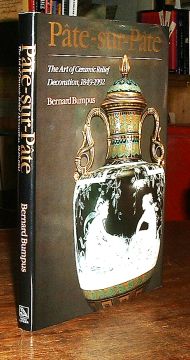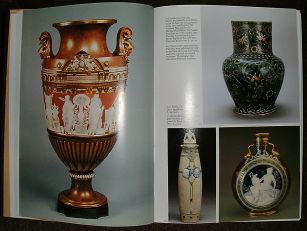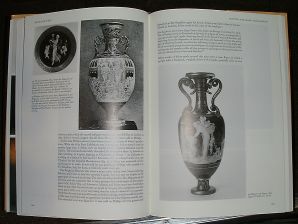INTRODUCTION
One of the few artistic
and beautiful styles of pottery decoration of the
nineteenth century ' This was how William Burton, a
leading turn-of-the-century potter, distinguished writer
on ceramics, and manager of Pilkington's Lancastrian
Pottery described pate-sur-pate in the 1910 edition of
the Encyclopaedia Britannia '
Pate-sur-pate -fate was an elaboiate and expensive method
of decorating porcelain in which a translucent cameo-like
image was built up by the application of many thin coats
of porcellaneous slip The technique was developed at the
end of the 1840s at the French national manufactory of
Sevres and greatly refined over the next ten years,
notably by Leopold Jules Gely and by the man who would
later be internationally celebrated as the greatest of
all pate-sur-pate artists. Marc Louis Solon, master of a
method he evolved over half a century
It was Solon who introduced the technique to England when
in 1870 at the time of the Franco Prussian war he left
Sevres to join Minton in Stoke-on-Trent Other
manufacturers in France, followed by those in Britain,
Germany, Russia, Italy, and Hungary, soon recognized the
decorative potential of. pate-sur-pate, which reached its
fullest and most widespread realization in the last
quarter of the nineteenth century Individual pieces and
displays drew interested comment whenever they were
included in international exhibitions In the USA, museums
and patrons acquired examples of the admired decoration
from exhibitors at Vienna and Philadelphia in the 1870s
the method itself was brought over by English artists in
the 1890s and later the eminent French ceramist Taxile
Doat made and taught pate-sur-pate for four years at
University City, Missouri, but production of the ware in
the USA was not extensive The twentieth century saw a
gradual decline in the manufacture of pate-sur-pate,
mainly on grounds of cost Sevres had probably ceased to
make it by 1930 Minton maintained output, although much
reduced, until the outbreak of World War II, when their
one re~ maming pate-sur-pate artist, Richard Bradbury,
left for military service In the post-1945 period two
attempts have been made to revive the process at Minton
using Solon's accounts as a guide Failing initially in
their efforts to get successive coats of slip to adhere,
the firm succeeded in 1991 in producing two handsome
vases to commemorate the 200th anniversary of Minton's
foundation in 1793. Historical precedents for ornamental
relief decoration were of two kinds antique stone cameos
and cameo glass in which a raised and carved upper layer
was set in relief against, and often revealed, a
different coloured ground, an effect imitated in the late
eighteenth century both by Josiah Wedgwood on his
jasper-ware medallions and plaques, and by Sevies in
biscuit porcelain, and the white painted decoration on
Limoges enamels which again relied for its effect on the
contrast between design and coloured ground However Solon
in an article written for The Studio in 1894, was at
pains to distinguish the quality of pate-sur-pate pate
from other methods of decoration with which it was compared:
The Wedgwood Jasper
ware, for instance, although offering likewise white
reliefs on coloured grounds, is as the reader is no doubt
well aware, produced by mechanical means Each part of a
given model is pressed separately in a plaster mould and
sub sequently stuck on the even surface of the piece to
be decorated It may be multiplied to an unlimited number
of copies, a careful workman is equal to the task A Pate
sur Pate bas relief, on the contrary, is always an
original, a repetition of it could only be made by the
artist who has executed the first one In the Limoges
enamels sometimes mentioned as presenting some analogy,
the difference is still better marked, for in this case
effect is not obtained by gradation of reliefs, but
rather of lights and shades The dark tint of the ground
is taken advantage of to form the shadows, and the white
enamel comes into play, just as white chalk intervenes in an
effective drawing on tinted paper.
The immediate inspiration ior pate sur-pate was in fact
provided by none of these sources The technique developed
at Sevres followed speculation about the in method used
to produce the raised white flowers on a Chinese celadon
vase the ceramics museum there These flowers were wrongly
thought to be translu- cent, and trials were carried out
to produce a similar decoiation . Success was achieved in
1849 when a sucrier decorated with raised insects
ornaments emerged from the kiln with the celadon ground
colour clearly visible through the decoration,
The subsequent application of the technique focused on
what Solon called "The successful management of those
transparencies". Great care and calculation was
required, as William Burton's account, relying on Solon's
own method, shows: As practised by M. Solon the
pate-sur-pate decoration took the form of paintings of
figure subjects or dainty ornamental designs in white
slip on a coloured porcelain ground of green, blue,
dark-grey or. black. On such grounds a thin wash of the
slip gives a translucent film, so that by washing on or
building up successive layers of slip sharpening the
drawing with modelling tools, or softening or rounding
the figure with a wet brush, the most delicate gradations
of tint can be obtained, from the brilliant white of the
slip to the full depth of the ground. This method was
rapidly adopted by all the principal European factories,
though nowhere was it carried to such perfection as at
Sevres and at Milton's. M. Taxile Doat has executed
extraordinary pieces in this style of decoration at
Sevres, and in the British Museum there is a large vase
of his, presented by the French government at the
beginning of the present century Sevres made no secret of
the technique and Victor de Luynes, a professor at the
Pans Conservatoire des Arts et Metiers, included an
account of it (reproduced in Appendix A) in his report on
the 1872 London International Exhibition' Solon also
described his working methods, first in a general
article, already quoted, in The Studio, later reissued by
Minton as a booklet, and again in the Art Journal in 1901
A concise account of the process, again written by Solon,
appealed in 1896 as a 'special contribution' in Rough
Notes on Pottery, a US publication Amongst the various
styles of decoration which the artist may borrow from the
potter, the process of Pate-sur-pate stands alone with
regard to the peculiar effects that may be obtained from
it Wedgwood's jasper reliefs are the nearest approach,
but the figures and the ornamentation with which jasper
ware is adorned, are all pressed in moulds, and simply
stuck on the surface The result is a work, which how ever
skilful in treatment, does not go beyond the refined
productions of a superior handicraft It is not so with
the Pate-sur-pate process A plain piece, made of a
porcelain body, coloured with metallic oxides, and still
in the clay State (that is to say, before it has"
been submitted to any firing) is taken in hand by the
artist Freely he sketches upon a subject of ( his own imagination The white porcelain
clay, diluted with water to consistency of batter, or, as
it is called, the 'slip', serves to produce the reliefs.
By means of a painting brush the slip is laid upon the
piece by successive coats care being taken to wait until
the coat is perfectly dry before applying another.
Failing that precaution the raised work might crack and
peel off Thus, by degrees, the reliefs attain respective
thicknesses They are then worked into with sharp iron
tools which scrape and smooth the inequalities of the
rough sketch, incise the details and delineate the
outlines, whilst the brush loaded with thicker slip,
brightens the whole work with sharply raised touches When
the piece is considered as completed and reach for the
oven, it is, from beginning to end, the original
production of the artist's hand.
But it is only through the action of the fire, which
causes the incipient state of vitrification of the mass,
that the translucency of certain parts will become
apparent when at work the artist has no means of
ascertaining the degree of transparency that the firing
will develop, he can only depend on his experience and
judgement All ends often in disappointment, for after the
piece has passed through the oven, to retrieve any
mistake, or to amend any accident has become an
impossibility One may rest satisfied if the fruit of a
long labor does not come from the firing split into
fragments, disfigured by unseemly blisters, in short, an
altogether worthless wreck Decoration in colored clays
are applied in the same manner The various colors are
obtained by mixing with the porcelain body, given
quantities of oxide of cobalt, chromium, iron, uranium,
titanium, and other metalloids These mixtures have to be
artfully compounded in such a way that the contraction
they undergo in the firing shall be equal in all cases.
In his Cantor Lecture delivered to the Society of Arts in
January 1881, the cera-mist Professor A H Church has left
an eye-witness impression of Solon 's working method,
which corroborated Solon's own technical account of his
procedure Church remarked 'It is marvellous to see Mr
Solon, as I have been privileged to see him, without
outlines or previous sketching, laying the wet
por-cellanous slip with a brush on the coloured ware in
the green state, and then carving the powdery substance
into forms of exquisite truth and tenderness' Although
these accounts suggest that the clay was not submitted to
any firing before work on it started, this was not
strictly correct To make the material easier to handle,
it might be passed through a low-fired hardening kiln The
point was made by Solon himself in The Studio and by
Frederick Alfred Rhead, who in 1513 contributed three
articles on the subject to the American magazine Keramic
Studio, summarized in Appendix B Rhead had been a pupil
of Solon at Minton, and retained a lifelong enthusiasm
for pate-sur-pate Neither Solon nor Rhead stated how many
coats of slip were necessary to build up the required re
lief, relying, no doubt, on experience and artistic
judgement The French ceramist Theodore Deck, writing
during his time as administrator of the Sevres
manufactory, was more specific, observing that thirty or
forty coats were usual, and that for this reason the
process was far too time-consuming
The reward for the artist of this lengthy procedure lay
in the charming effects that could be achieved by
manipulating thicker and thinner reliefs The translucent
quality of the medium could be used to virtuoso effect in
suggesting distance and in the realistic rendering of
clouds, water, and diaphanous drapery which revealed the
form of the human body, particularly the female figure
Transparent effects of this kind made great demands on
the skill of the pate-sur-pate artist, as Solon made
clear, and they were the feature most admired by
contemporaries, among them Leon Arnoux, Minton's art
director The subtleties of the process could be further
enhanced by the use of delicate tones, one of which
reminded the an critic Philippe Burty of a 'nuage de
creme verse dans une tasse de the' Pate-sur-pate was the
description originally given to the technique at the
Sevres manufactory, but variations on this terminology
were soon introduced These included pate d'application,
pate rapportee, and sometimes pate blanche or pate
coloree The last term referred to decorations with
coloured paste, which were applied, as Solon explained in
his contribution to Rough Notes on Pottery, the same way In the 1860s Arnoux
described the technique as pate-sur-pate in his
exhibition reports and was probably the first person to
introduce, the term to England
Barbotine was another term used in France, particularly
in Limoges Derived from the Old French bourbe, meaning
mud or clay, barbotine can be translated as 'slip' or
liquid clay, and was used by de Luynes in this sense in
his description of pate-sur-pate quoted in Appendix A
Confusingly, it was also the name given to a decorative
process unconnected with pate-sur-pate, referring to a
method of painting with slip on earthenware developed in
the early 1870s by Ernest Cha plet Solon included a
description of this successful, but short lived, process
in his account of the revival of French faience
'Barbotine painting' 'consisted in mixing fusible colours
with clay and opaque substances, so that they could be
employed in any degree of thickness, the sharpness of the
artist's touch was not impaired by the firing, when
completed, the work had the appearance of an oil
painting' In 1873 the Limoges firm of Haviland opened an
atelier in Pans Auteuil which made work of this type, and
other manufacturers were quick to follow suit The
popularity of barbotme painting lasted for only a few
years an the Auteuil studio closed in 1882 In Limoges,
presumably because of the Havi-land connection, the name
barbotme seems to have been used indiscriminately to
describe either Auteil-type barbotine or pate-sur -pate
When the term barboine appears in Limoges exhibition
catalogues, the imprecise terminology means that it is
not always possible to deteimme which product is being
refferd to. This Problem is discussed again in the
section in chapter 3 on the Limoges; Potteries To add to
the confusion, barbotine is used today as a generic term
for majolica.
In Britain the technique has commonly been described as
pate-sur-pate since its introduction The literal
translation, paste-on-paste, sometimes used in English
and American publications, is both misleading and
inappropriate as it can apply equally to other
techniques, among them slip-trailing and tube-lining From
March 1878 until the end of September 1883 the Minton
records refer to 'M S P', the 'Minton Solon Process',
rather than pate-sur-pate Although no obvious change can
be detected in the appearance of the work, the initials
may have been adopted as a patent to differentiate
Solon's procedure from that of several other English
manufacturers who were making pate-sur-pate at die time
Elsewhere in Europe, pate-sur-pate was the accepted name
for the process, used tor example at Meissen and KPM
Berlin, though German journalists sometimes referred to
Pinselmalerei The firm of Villeroy & Boch is an
exception and made at its Mettlach works a range named
Phanolith, in which plaques and other subjects were
decorated in a manner similar to pate-sur-pate In the
USA, too, pate-sur-pate was the term in general use.
During the second half of the nineteenth century and the
first quarter of the twentieth, pate-sur-pate,
paiticularly the work of Solon and Taxile Doat, was much
admired.
The designer Lewis F Day, for instance, thought the
tianspa-rency and modelling of Solon's work 'one of the
most beautiful of modern times', while William Burton
placed it in 'the post of honour among the artistic
productions of the nineteenth century' Museum curators,
too, were equally enthusiastic Edwin Atlee Barber, the
leading American ceramic historian at the time and
curator of the Pennsylvania Museum in Philadelphia, wrote
of 'this beautiful art', while Bernard Rackham, keeper of
ceramics at the Victoria & Albert Museum, regarded
Solon's work 'as amongst the best things of the ceramic
art of the 19th century' The British Museum's keeper of
ceramics, R L Hodson, observed 'Mr Solon made no secret
of his art Every stage of his procedure was clearly
explained One could borrow everything from him
-everything except the one thing most needful - the touch
of his peculiar genius in the ceramic history of the
nineteenth century few names would stand out in higher
relief than that of the master of pate-sur-pate After
World War I pate-sur-pate, like most nineteenth-century
fashions, declined in populanty 'Writing in 1940 in A
Potter's Book, Bernard Leach observed sourly: 'It would
be difficult to find a better example of what should not
be done with clay' Today Solon's elegant works, and those
of the many other talented artists who practised the
technique, are once more appreciated for the skill and
beauty of their achievement.
|


